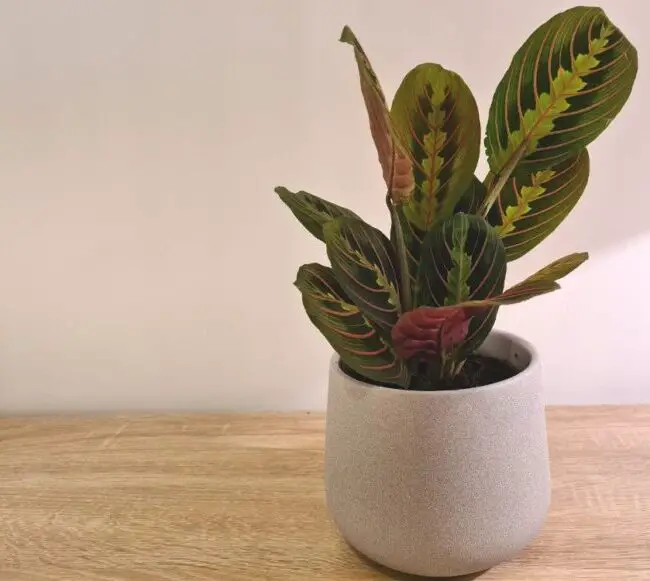Do prayer plants like sun? Absolutely! If you’re a plant enthusiast, you’ve probably heard of the captivating beauty and unique behavior of prayer plants. These vibrant and lush houseplants, scientifically known as Maranta leuconeura, have gained popularity for their stunning foliage and intriguing ability to fold their leaves up at night.
But when it comes to sunlight, what’s the verdict? Can prayer plants thrive under the warm embrace of the sun? In this article, we’ll delve into the sunny side of prayer plants and explore the ideal light conditions for these remarkable botanical wonders. So, let’s shed some light on the question, “Do prayer plants like sun?”
Do Prayer Plants Like Sun?
Prayer plants, scientifically known as Maranta leuconeura, are popular houseplants known for their attractive foliage and unique ability to fold their leaves at night. If you are considering getting a prayer plant for your home or office, one of the questions you might have is whether they like sun.
In this article, we will explore the light preferences of prayer plants and provide you with all the information you need to ensure your plant thrives in its environment.
Light Requirements of Prayer Plants
Prayer plants are native to the shaded understory of tropical forests, where they receive filtered sunlight or indirect light. Consequently, these plants have adapted to thrive in low to medium light conditions.
Although they can tolerate some degree of direct sunlight, excessive exposure to the sun’s rays can harm their delicate foliage.
Here are some key points to consider regarding the light requirements of prayer plants:
1. Indirect Light
Prayer plants prefer bright, indirect light. This means they should be placed in a location where they receive bright but indirect sunlight.
A few feet away from a window with a sheer curtain or in a room with bright, natural light is an ideal spot for a prayer plant.
2. Avoiding Direct Sunlight
While prayer plants can tolerate some direct sunlight, it’s best to avoid placing them in direct sunlight for extended periods. The intense rays of the sun can lead to sunburn and scorched leaves.
If you notice that your prayer plant’s leaves are turning yellow or developing brown spots, it may be a sign that it is receiving too much direct sunlight.
3. Low Light Tolerance
On the other end of the spectrum, prayer plants can also tolerate low light conditions, making them suitable for areas with less natural light.
However, it’s important to strike a balance between providing enough light for the plant to thrive and avoiding excessive darkness. Too little light can slow down growth and result in leggy, weak stems.
Read More: About Is Your Lucky Bamboo Stalk Turning Light Green?
How to Provide Adequate Light for Your Prayer Plant
Now that we have established that prayer plants prefer indirect light, let’s explore some practical tips for providing the right amount of light to keep your plant happy and healthy.
1. Placement
Finding the perfect spot for your prayer plant is crucial for its well-being. Consider the following when deciding on a location:
- Place your prayer plant a few feet away from a north or east-facing window. These directions typically provide the ideal balance of bright, indirect light.
- Avoid placing your plant near south or west-facing windows, as they tend to receive more direct sunlight. If you have no other option, use a sheer curtain or a light-filtering blind to diffuse the sunlight.
- If your home lacks natural light, you can use artificial grow lights to supplement the available light. Choose grow lights with a spectrum similar to natural sunlight, and position them a few feet above the plant to mimic the intensity of indirect light.
2. Monitor Light Conditions
Observing your plant’s response to light conditions can help you determine if it needs a change in placement. Keep an eye on its leaves and watch out for these indicators:
- If the leaves start to curl or fold up during the day, it may be a sign that the plant is receiving too much direct sunlight. Move it slightly further from the light source and observe how it responds.
- Yellowing, bleached, or brown spots on the leaves can be a sign of sunburn. If this occurs, provide more shade or filter the light to protect your plant from further damage.
- If your prayer plant starts stretching towards the light source, it may indicate insufficient light. Consider moving it closer to a window or providing additional artificial lighting.
3. Rotate the Plant
To ensure even growth and prevent your prayer plant from leaning towards the light, rotate it every few weeks. This will allow all sides of the plant to receive adequate light exposure, resulting in more balanced and symmetrical growth.
Prayer plants prefer bright, indirect light and can tolerate low to medium light conditions. While they can handle some direct sunlight, prolonged exposure to intense rays can harm their foliage. By providing the right amount of light and monitoring your plant’s response, you can create an optimal environment for your prayer plant to thrive.
Remember to find a suitable placement, monitor light conditions, and rotate the plant periodically for even growth. With proper care and attention, your prayer plant will reward you with its vibrant and beautiful foliage.
Frequently Asked Questions (FAQs)
Yes, prayer plants do like sun, but they prefer indirect sunlight or partial shade. Direct sunlight can scorch their leaves, causing them to develop brown spots or curl at the edges. It’s best to place prayer plants in a location where they receive bright, indirect light.
Prayer plants thrive when they receive bright, indirect light for about 6-8 hours a day. They can tolerate some direct sunlight in the morning or evening, but it’s important to avoid exposing them to intense midday sun.
No, it’s not recommended to place prayer plants in a window with full sun. Direct sunlight can be too harsh for their delicate leaves and may cause damage. It’s best to provide them with bright, filtered light instead.
If a prayer plant doesn’t receive enough sunlight, it may become leggy and weak. The leaves may lose their vibrant colors, and the plant may stop producing new growth. Inadequate sunlight can also affect the plant’s ability to photosynthesize and thrive overall.
Yes, prayer plants can survive in low-light conditions, but they may not thrive or display their vibrant foliage. In low-light environments, their growth may slow down, and their leaves may become dull. It’s best to provide them with bright, indirect light whenever possible.
No, prayer plants are typically grown indoors as houseplants and are not suitable for full sun exposure outdoors. They prefer the controlled environment of indoor spaces, where they can receive the right amount of light and temperature.
If your prayer plant gets too much sun, it may show signs of stress such as leaf discoloration, browning, or curling. To remedy this, move the plant to a location with less direct sunlight, or provide some shade using sheer curtains or blinds.
Yes, prayer plants can be grown under artificial light. If you don’t have access to sufficient natural light, you can use fluorescent or LED grow lights. Position the lights about 12-18 inches above the plant and keep them on for 12-14 hours a day to simulate natural daylight.
Read More: About Why Do Tomato Seedling Leaves Point Up at Night?
Final Thoughts
Prayer plants, also known as Maranta leuconeura, thrive best in bright, indirect sunlight. While they can tolerate some direct sunlight, excessive exposure may result in leaf damage. It is important to find the right balance, as too little light can cause the plant to become leggy and lose its vibrant colors. Placing your prayer plant near a window with filtered light or using sheer curtains can provide the ideal lighting conditions.
Remember, prayer plants prefer dappled sunlight or shade rather than harsh direct sun. So, if you’re wondering, “Do prayer plants like sun?” the answer is that they enjoy bright but indirect sunlight to thrive and maintain their vibrant appearance.
Auto Amazon Links: No products found.
Perfect Plants Christmas Tree Saver 8oz. | Easy Use Xmas Tree Preserver Food | Have Healthy Green Christmas Trees All Holiday Season
$9.97 (as of December 8, 2025 01:01 GMT +00:00 - More info- Product prices and availability are accurate as of the date/time indicated and are subject to change. Any price and availability information displayed on [relevant Amazon Site(s), as applicable] at the time of purchase will apply to the purchase of this product.
Kaiedos Christmas Tree Watering Funnel - 39 Inch Funnel, Reusable Design, Makes Watering Your Live Tree a Snap!
$14.99 (as of December 8, 2025 01:01 GMT +00:00 - More info- Product prices and availability are accurate as of the date/time indicated and are subject to change. Any price and availability information displayed on [relevant Amazon Site(s), as applicable] at the time of purchase will apply to the purchase of this product.
Forest Fresh Christmas Tree Preservative Tablets – Tree Water Additive for Live Fresh-Cut Trees – Keeps Trees Hydrated and Reduces Needle Drop – Non-Toxic, Made in USA – 1 Packet (8 Tablets)
$5.99 (as of December 8, 2025 01:01 GMT +00:00 - More info- Product prices and availability are accurate as of the date/time indicated and are subject to change. Any price and availability information displayed on [relevant Amazon Site(s), as applicable] at the time of purchase will apply to the purchase of this product.
Christmas Tree Watering Funnel-39 Inch Adjustable 3-Section Long Funnel Spout Funnel Watering System Xmas Plant Watering Tool for Large Indoor Outdoor Plants
$14.59 (as of December 8, 2025 01:01 GMT +00:00 - More info- Product prices and availability are accurate as of the date/time indicated and are subject to change. Any price and availability information displayed on [relevant Amazon Site(s), as applicable] at the time of purchase will apply to the purchase of this product.
EZMeetU Christmas Tree Watering Funnel, 47 Inch Flower Shape Adjustable 6 Section Design, Christmas Tree Watering System, Christmas Tree Waterer, Long Funnel Wide Opening Reusable, Plant Watering Tool
$15.99 (as of December 8, 2025 01:01 GMT +00:00 - More info- Product prices and availability are accurate as of the date/time indicated and are subject to change. Any price and availability information displayed on [relevant Amazon Site(s), as applicable] at the time of purchase will apply to the purchase of this product.
Muddy Mat® Shown on TV Super Absorbent Microfiber Dog Door Mat for Muddy Paws, Non-Slip Washable Pet Rug, Quick Dry Chenille Entryway Carpet, Machine Washable Indoor Outdoor mat, Grey 30"x19"
$24.95 (as of December 8, 2025 17:23 GMT +00:00 - More info- Product prices and availability are accurate as of the date/time indicated and are subject to change. Any price and availability information displayed on [relevant Amazon Site(s), as applicable] at the time of purchase will apply to the purchase of this product.
Snow Joe Premium Enviro Blend Ice Melt, Green-Coated Deicer Crystals, 50 lb - Safer Melter for Vegetation, Concrete & Metals w/ Anti-Corrosion Calcium Magnesium Acetate
$32.97 (as of December 8, 2025 17:23 GMT +00:00 - More info- Product prices and availability are accurate as of the date/time indicated and are subject to change. Any price and availability information displayed on [relevant Amazon Site(s), as applicable] at the time of purchase will apply to the purchase of this product.
Zevo Flying Insect Trap Official Refill Cartridges - Fits Both Zevo Trap & MAX Indoor Fly Trap - Authentic Trap+Lock Technology to Catch Gnats, House & Fruit Flys (4 Official Refill Cartridges)
$14.97 (as of December 8, 2025 17:23 GMT +00:00 - More info- Product prices and availability are accurate as of the date/time indicated and are subject to change. Any price and availability information displayed on [relevant Amazon Site(s), as applicable] at the time of purchase will apply to the purchase of this product.
OLANLY Dog Door Mat for Muddy Paws 30x20, Absorbs Moisture and Dirt, Absorbent Non-Slip Washable Doormat, Quick Dry Chenille Mud Mat for Dogs, Entry Indoor Entryway Carpet for Inside Floor, Grey
$9.99 (as of December 8, 2025 17:23 GMT +00:00 - More info- Product prices and availability are accurate as of the date/time indicated and are subject to change. Any price and availability information displayed on [relevant Amazon Site(s), as applicable] at the time of purchase will apply to the purchase of this product.
Advion Cockroach Gel Bait, 4 Tubes x 30-Grams, 1 Plunger and 2 Tips, German Roach Insect Pest Control, Indoor and Outdoor Use, Roach Killer Gel for American, German and Other Major Cockroach Species
$26.46 (as of December 8, 2025 17:23 GMT +00:00 - More info- Product prices and availability are accurate as of the date/time indicated and are subject to change. Any price and availability information displayed on [relevant Amazon Site(s), as applicable] at the time of purchase will apply to the purchase of this product.











